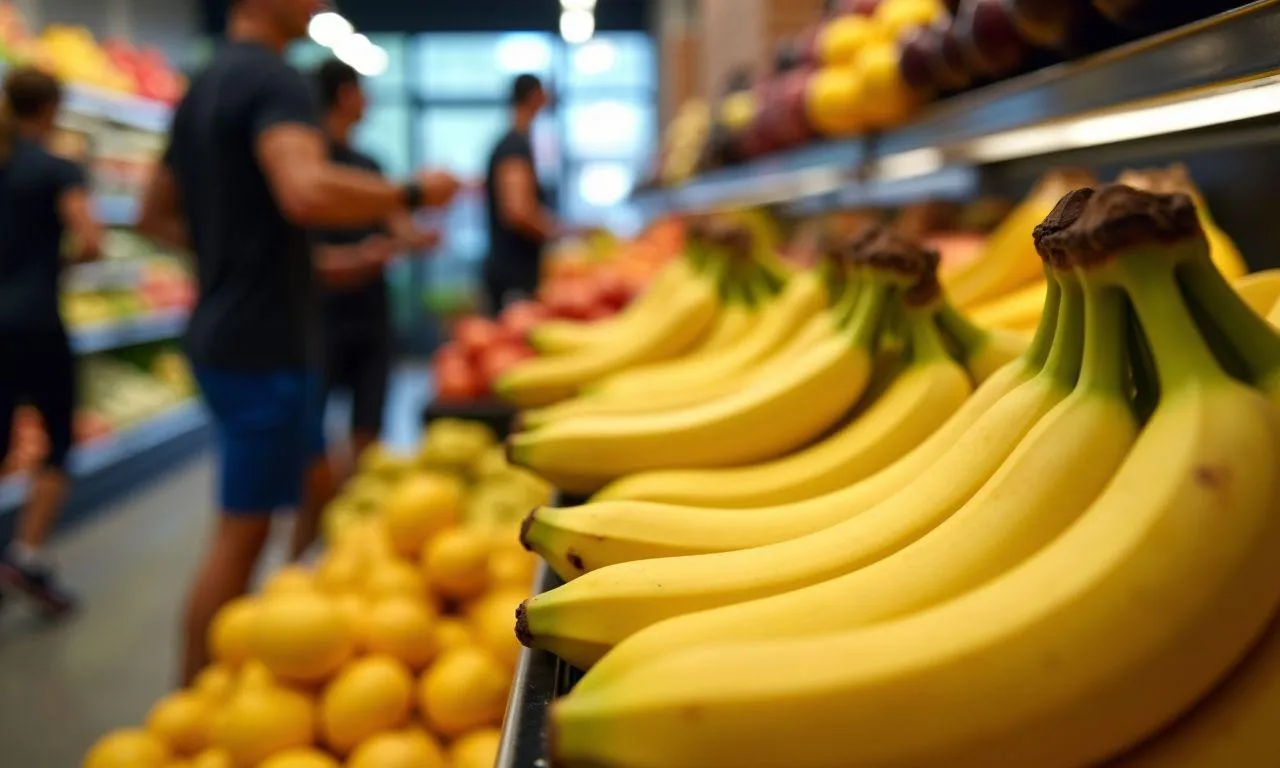Bananas – Radioactive Enhancement for Runners
Bananas constitute an optimal snack for both the average bread enthusiast and the sprint world champion. However, there exists a genuine risk of ionizing radiation. Fact or fiction? It is worth answering these and other questions before filling our shopping carts with bananas from the supermarket. Should we be concerned about radiation and parasitic infections when consuming bananas?
Table of Contents
1. The Rule of Sixty Minutes
One of the most crucial tasks following a workout, particularly strength training, is to quickly replenish depleted glycogen stores. In strength training sessions, up to 80% of the energy originates from glucose breakdown. The body is much more inclined to restore its lost reserves immediately post-exercise, a phenomenon known as supercompensation, driven by processes such as accelerated transport of blood glucose to the cell interior and rapid glycogen regeneration. Scientific findings indicate that missing a meal for more than 2 hours following the completion of a workout could lead to a weakening of glycogen synthesis efficiency. The rule of sixty minutes suggests that a meal should be consumed within an hour of concluding the workout. Rapid replenishment of glycogen reserves is especially significant when the interval between consecutive intense training sessions is 8 hours or less. There have also been studies that did not demonstrate significant differences in glycogen synthesis efficiency between individuals who ate immediately after exercising and those who waited at least 2 hours for their meal.2. Bananas - their nutritional value
Bananas are not only delicious, but also remarkably nutritious. In 100 grams, they contain: - 97 calories, - 1 gram of protein, - 23.5 grams of carbohydrates, - 1.7 grams of fiber, - 0.33 grams of fat, - 6 milligrams of calcium, - 33 milligrams of magnesium, - 396 milligrams of potassium, - 0.5 milligrams of niacin. Notably, bananas have a high concentration of carbohydrates, simple sugars, potassium, and magnesium. Therefore, bananas are an excellent component of a nutritious meal after a workout.3. A beverage that supplies energy
Research has demonstrated that bananas can be as effective during exercise as a beverage containing 6% carbohydrates. In one study, trained cyclists underwent double training cycles – the first with a beverage, the second with a banana (bananas were ingested simultaneously with water, ensuring the amount of fluids consumed in both groups was equal). Participants consumed 0.2 g of carbohydrates per kilogram of body weight every 15 minutes of exercise. It was found that in both cases, glucose levels, inflammation, and oxidative stress were the same. However, the consumption of bananas compared to the consumption of beverages resulted in an increase in dopamine levels. This increase was not substantial enough to cause any effects. Dopamine is a water-soluble antioxidant, but it does not penetrate the brain and has no impact on mood. The banana peel contains a higher concentration of dopamine than the fruit itself, providing a basis for further research into the use of supplements derived from banana peels.4. The diet of world champions - daily 16 bananas
Yohan Blake - a Jamaican lightweight athlete, sprinter, and world championship gold laureate. Is the secret to his speed rooted in his diet? This runner affirms that he consumes up to 16 bananas daily, and in the past, this number reached up to 30 of these fruits. He justifies this with his fondness for the taste of bananas as well as the high potassium content in these fruits. Bananas are regarded as an excellent source of this mineral since the requirement for this component in a high-performance athlete is significantly higher. The high potassium content in bananas is considered an advantage. Yet, could it also serve as a source of ionizing radiation?5. Bananas demonstrate sufficient radioactivity to trigger an alarm
Bananas indeed exhibit radioactive properties, possessing a radioactive isotope of potassium (40K) in their composition which, upon breakdown, releases β particles. The content of this isotope is merely 0.0117% of the total potassium concentration in bananas. Assuming a large banana contains approximately 600 mg of potassium, the average amount of radioactive element will be 7.02 × 10^(-5) g. If we consume one banana a day, our annual exposure to ionizing radiation will increase by 0.035 millisieverts. Sievert is a unit of measurement for the impact of ionizing radiation on living organisms, and this amount is significantly smaller than, for example, exposure from X-rays, which can reach up to 10 mSv. Consequently, we should not be concerned, as bananas do not pose a significant radiation risk for the average consumer.6. Are banana ends truly a haven for lamblia or spider eggs?
Banana ends, contrary to popular belief, do not harbor lamblia nor spider eggs. Giardia lamblia, a parasite widespread globally, is present in up to 10% of the Polish population. It is transmitted through the fecal-oral route, belonging to the so-called dirty hand diseases. Infection occurs when cysts (one of the forms this parasite takes) enter the mouth. However, cysts can be found on any unwashed fruit, not just bananas. Regarding spider eggs, cases of exotic spider eggs being delivered with bananas are extremely rare. In 2013, a British woman in a supermarket had the luck to buy bananas in which she found eggs of one of the most dangerous spiders in the world. The spider itself was hidden in a bunch of bananas and transported to her workplace by a 53-year-old British office worker. Nevertheless, this does not change the fact that these are sporadic cases and we should not give up bananas in our diet.
Latest Nutrition Plans

Express Shape – 1600 kcal Protein Nutrition Plan – 3 Weeks to a Healthier You

Accelerated Transformation - a protein-rich plan with 1600 calories for 14 days

Revolutionize Your Body - A 7-Day Fast Protein Plan for Extraordinary Weight Loss

Ultra-Low Carb Adventure - A 4-Week, 1600 kcal Plan for a Lighter, Healthier You

Energize Your Life - A 4-Week High-Protein Slimming Plan with 1500 kcal for Energy and Weight Reduction

Sven's Plan - A 4-Week, 1500 kcal Slimming Program for Healthy Energy and Transformation

Express diet 1300 kcal - quick reduction in 4 weeks according to Sven

Step Up Your Life - A 4-Week, 1400 kcal High-Protein Slimming Plan

Fit Body - A 4-Week, 1400 kcal Healthy Slimming Diet for Optimal Results

Slim Plan 28 - A 28-Day, 2000 kcal Weight Loss Plan for Optimal Results

Dream Shape - A 4-Week, 1800 kcal Weight Loss Plan for Lasting Change.

Protein Power 4 - A 4-Week, 2200 kcal High-Protein Diet for Energy and Optimal Weight Loss

